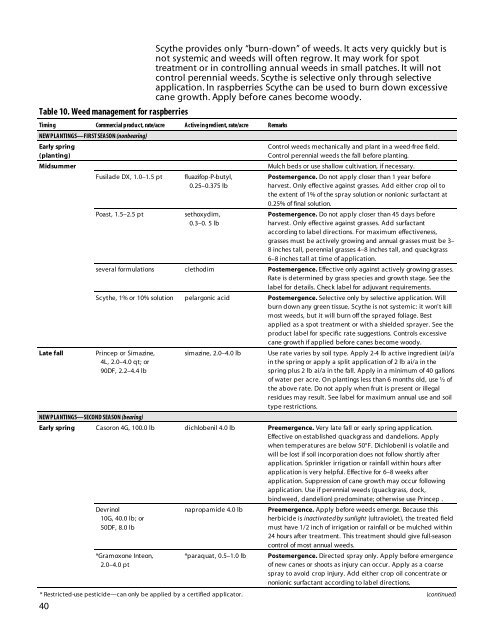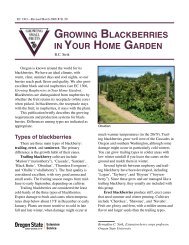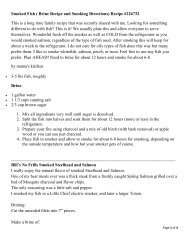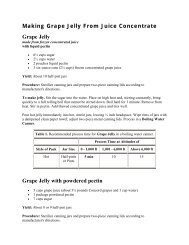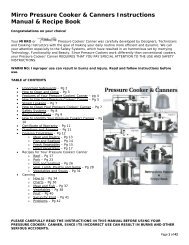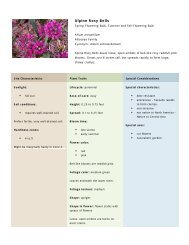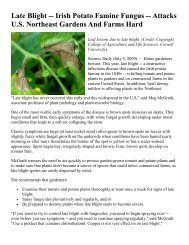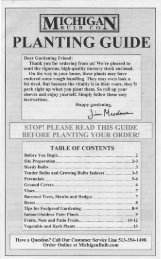Strawberry and Raspberry Pest Management in Wisconsin
Strawberry and Raspberry Pest Management in Wisconsin
Strawberry and Raspberry Pest Management in Wisconsin
Create successful ePaper yourself
Turn your PDF publications into a flip-book with our unique Google optimized e-Paper software.
Table 10. Weed management for raspberries<br />
40<br />
Scythe provides only “burn-down” of weeds. It acts very quickly but is<br />
not systemic <strong>and</strong> weeds will often regrow. It may work for spot<br />
treatment or <strong>in</strong> controll<strong>in</strong>g annual weeds <strong>in</strong> small patches. It will not<br />
control perennial weeds. Scythe is selective only through selective<br />
application. In raspberries Scythe can be used to burn down excessive<br />
cane growth. Apply before canes become woody.<br />
Tim<strong>in</strong>g Commercial product, rate/acre Active <strong>in</strong>gredient, rate/acre Remarks<br />
NEW PLANTINGS—FIRST SEASON (nonbear<strong>in</strong>g)<br />
Early spr<strong>in</strong>g<br />
(plant<strong>in</strong>g)<br />
Control weeds mechanically <strong>and</strong> plant <strong>in</strong> a weed-free field.<br />
Control perennial weeds the fall before plant<strong>in</strong>g.<br />
Midsummer Mulch beds or use shallow cultivation, if necessary.<br />
Fusilade DX, 1.0–1.5 pt fluazifop-P-butyl,<br />
0.25–0.375 lb<br />
Poast, 1.5–2.5 pt sethoxydim,<br />
0.3–0. 5 lb<br />
Postemergence. Do not apply closer than 1 year before<br />
harvest. Only effective aga<strong>in</strong>st grasses. Add either crop oil to<br />
the extent of 1% of the spray solution or nonionic surfactant at<br />
0.25% of f<strong>in</strong>al solution.<br />
Postemergence. Do not apply closer than 45 days before<br />
harvest. Only effective aga<strong>in</strong>st grasses. Add surfactant<br />
accord<strong>in</strong>g to label directions. For maximum effectiveness,<br />
grasses must be actively grow<strong>in</strong>g <strong>and</strong> annual grasses must be 3–<br />
8 <strong>in</strong>ches tall, perennial grasses 4–8 <strong>in</strong>ches tall, <strong>and</strong> quackgrass<br />
6–8 <strong>in</strong>ches tall at time of application.<br />
several formulations clethodim Postemergence. Effective only aga<strong>in</strong>st actively grow<strong>in</strong>g grasses.<br />
Rate is determ<strong>in</strong>ed by grass species <strong>and</strong> growth stage. See the<br />
label for details. Check label for adjuvant requirements.<br />
Scythe, 1% or 10% solution pelargonic acid Postemergence. Selective only by selective application. Will<br />
burn down any green tissue. Scythe is not systemic: it won't kill<br />
most weeds, but it will burn off the sprayed foliage. Best<br />
applied as a spot treatment or with a shielded sprayer. See the<br />
product label for specific rate suggestions. Controls excessive<br />
cane growth if applied before canes become woody.<br />
Late fall Pr<strong>in</strong>cep or Simaz<strong>in</strong>e,<br />
4L, 2.0–4.0 qt; or<br />
90DF, 2.2–4.4 lb<br />
NEW PLANTINGS—SECOND SEASON (bear<strong>in</strong>g)<br />
simaz<strong>in</strong>e, 2.0–4.0 lb Use rate varies by soil type. Apply 2-4 lb active <strong>in</strong>gredient (ai)/a<br />
<strong>in</strong> the spr<strong>in</strong>g or apply a split application of 2 lb ai/a <strong>in</strong> the<br />
spr<strong>in</strong>g plus 2 lb ai/a <strong>in</strong> the fall. Apply <strong>in</strong> a m<strong>in</strong>imum of 40 gallons<br />
of water per acre. On plant<strong>in</strong>gs less than 6 months old, use ½ of<br />
the above rate. Do not apply when fruit is present or illegal<br />
residues may result. See label for maximum annual use <strong>and</strong> soil<br />
type restrictions.<br />
Early spr<strong>in</strong>g Casoron 4G, 100.0 lb dichlobenil 4.0 lb Preemergence. Very late fall or early spr<strong>in</strong>g application.<br />
Effective on established quackgrass <strong>and</strong> d<strong>and</strong>elions. Apply<br />
when temperatures are below 50°F. Dichlobenil is volatile <strong>and</strong><br />
will be lost if soil <strong>in</strong>corporation does not follow shortly after<br />
application. Spr<strong>in</strong>kler irrigation or ra<strong>in</strong>fall with<strong>in</strong> hours after<br />
application is very helpful. Effective for 6–8 weeks after<br />
application. Suppression of cane growth may occur follow<strong>in</strong>g<br />
application. Use if perennial weeds (quackgrass, dock,<br />
b<strong>in</strong>dweed, d<strong>and</strong>elion) predom<strong>in</strong>ate; otherwise use Pr<strong>in</strong>cep .<br />
Devr<strong>in</strong>ol<br />
10G, 40.0 lb; or<br />
50DF, 8.0 lb<br />
*Gramoxone Inteon,<br />
2.0–4.0 pt<br />
napropamide 4.0 lb Preemergence. Apply before weeds emerge. Because this<br />
herbicide is <strong>in</strong>activated by sunlight (ultraviolet), the treated field<br />
must have 1/2 <strong>in</strong>ch of irrigation or ra<strong>in</strong>fall or be mulched with<strong>in</strong><br />
24 hours after treatment. This treatment should give full-season<br />
control of most annual weeds.<br />
*paraquat, 0.5–1.0 lb Postemergence. Directed spray only. Apply before emergence<br />
of new canes or shoots as <strong>in</strong>jury can occur. Apply as a coarse<br />
spray to avoid crop <strong>in</strong>jury. Add either crop oil concentrate or<br />
nonionic surfactant accord<strong>in</strong>g to label directions.<br />
* Restricted-use pesticide—can only be applied by a certified applicator. (cont<strong>in</strong>ued)


